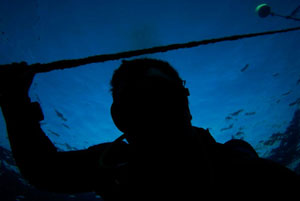Does It Have to be Night for Low Visibility Dives

Limited visibility comes in all shapes and sizes: reduced light due to depth, limited light due to overhead (wrecks) and no light due to overhead (caves). Each of these factors requires slightly different considerations and all should be considered limited visibility diving. There are some other factors that can turn what should be a good visibility dive into a limited visibility dive. When diving in wrecks exhaled bubbles can dislodge silt, rust or fragile building materials from the ceiling of the wreck. There are also the times when divers in front of you kick up silt in both wrecks and caves which can sometimes bring a dive to no-visibility.
One of the key objectives is that you never get lost, and the same goes for your buddy or team. There are many ways to maintain contact with others underwater and to perform underwater navigation so you don’t get lost. Dive lights allow you to stay in contact and communicate with others on the dive team, reels allow you to run a line leading back to the exit point and, when not around ferrous metals, a compass will do the trick. If the dive is or becomes a limited visibility dive, your options are reduced. Any time a diver is in an overhead environment, wreck or cave, they should also have a line that leads them to the exit point and contact with the line should always be maintained.
With minimal additional equipment and very little additional dive planning, limited visibility diving can be accomplished. Some of the best dives can be performed in limited visibility and for some sites, limited visibility is the best it will ever get.
For more information on limited visibility diving or to locate an dive center in your area please visit us at /sdi/get-certified/Night-Limited-Visibility-Diver/
Contact SDI TDI and ERDI
If you would like more information, please contact:
Tel: 888.778.9073 | 207.729.4201
Email: Worldhq@tdisdi.com
Web: https://www.tdisdi.com
Facebook: www.facebook.com/TechnicalDivingInt


发表评论
想加入讨论吗?请发表您宝贵的意见!